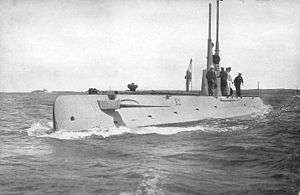USS E-2 (SS-25)
USS E-2 (SS-25) was an E-class submarine of the United States Navy. Originally named Sturgeon, the boat was launched on 15 June 1911 by the Fore River Shipyard, Quincy, Massachusetts; sponsored by Ms. Margaret Nelson Little; renamed E-2 on 17 November 1911; and commissioned on 14 February 1912, Ensign C. N. Hinkamp in command.[1]
 USS E-2 | |
| History | |
|---|---|
| Name: | USS E-2 |
| Builder: | Fore River Shipyard, Quincy, Massachusetts |
| Laid down: | 22 December 1909 |
| Launched: | 16 June 1911, as USS Sturgeon |
| Commissioned: | 14 February 1912 |
| Decommissioned: | 20 October 1921 |
| Renamed: | USS E-2, 17 November 1911 |
| Reclassified: | SS-25, 17 July 1920 |
| Fate: | Sold for scrap, 19 April 1922 |
| General characteristics | |
| Class and type: | E-class submarine |
| Displacement: |
|
| Length: | 135 ft 3 in (41.22 m) |
| Beam: | 14 ft 7 in (4.45 m) |
| Draft: | 11 ft 8 in (3.56 m) |
| Installed power: |
|
| Propulsion: |
|
| Speed: |
|
| Test depth: | 200 ft (61 m) |
| Capacity: | 8,486 US gal (32,120 l) diesel fuel |
| Complement: | 1 officer and 19 enlisted |
| Armament: | 4 × 18-inch (450 mm) torpedo tubes (4 torpedoes) |
Service history
Serving in the Atlantic Submarine Flotilla, E-2 sailed out of Newport, Rhode Island for developmental exercises and training. From 5 January-21 April 1914, she cruised to Guantanamo Bay and the Gulf of Mexico. She returned to Naval Station Newport on 27 July, for training operations for the remainder of the summer and from February–May 1915 off Florida.[1]
On 19 June, she entered New York Navy Yard for overhaul.[1] While sitting in dry dock Number 2, [2] E-2 was victim of a violent explosion and fire on 15 January 1916 when hydrogen gas ignited during conditions of severe battery testing; tests made under the direction of the Edison Storage Battery Company.[1] At the time, E-2 was the test submarine for new nickel battery designed to eliminate the danger from chlorine gas asphyxiation. There were 32 men aboard the submarine at the time of the explosion, consisting of both crew and civilian electricians and mechanics making repairs.[2] Four men were killed and seven injured.[1] The government investigation, led by then Lieutenant Chester W. Nimitz, pointed blame away from the submarine's commanding officer, then Lieutenant Charles M. Cooke, Jr..[3]
On 13 March, E-2 was placed out of commission for use as a laboratory, for exhaustive tests of the Edison storage battery. Recommissioned on 25 March 1918, E-2 served in training and experimental work at New London until 16 May. Two days later she arrived at Norfolk to operate against enemy submarines off Cape Hatteras. From 21 May-27 August, she made four war patrols, sighting a large enemy submarine for which she made extended submerged search on her last patrol. E-2 was commended by the Chief of Naval Operations for two of these anti-submarine patrols, which were exceptionally long for a submarine of her size.[1]
Returning to New London on 31 August 1918, E-2 made two more patrols before the end of the war, then returned to training student officers and qualifying men for duty in submarines. She sailed from New London to Norfolk on 19 April 1920, arriving two days later. There she was placed in commission in ordinary on 18 July 1921. On 17 September, she sailed for Philadelphia Navy Yard where she was decommissioned on 20 October and sold on 19 April 1922.[1]
References
- This article incorporates text from the public domain Dictionary of American Naval Fighting Ships. The entry can be found here.
- "E-2". Naval History and Heritage Command. Retrieved 15 January 2016.
- "2 Killed on U.S. Submarine Blown up in Brooklyn Dock". The Evening World. New York. January 15, 1916. p. 1. Retrieved 15 January 2016.
- "Naval Board of Inquiry proceedings regarding culpable explosion of the Edison battery installation". The New York Times. 16 February 1916. Retrieved 15 January 2016.
External links
- Photo gallery of USS E-2 at NavSource Naval History
- Video of the U.S.S. E-2 Underway